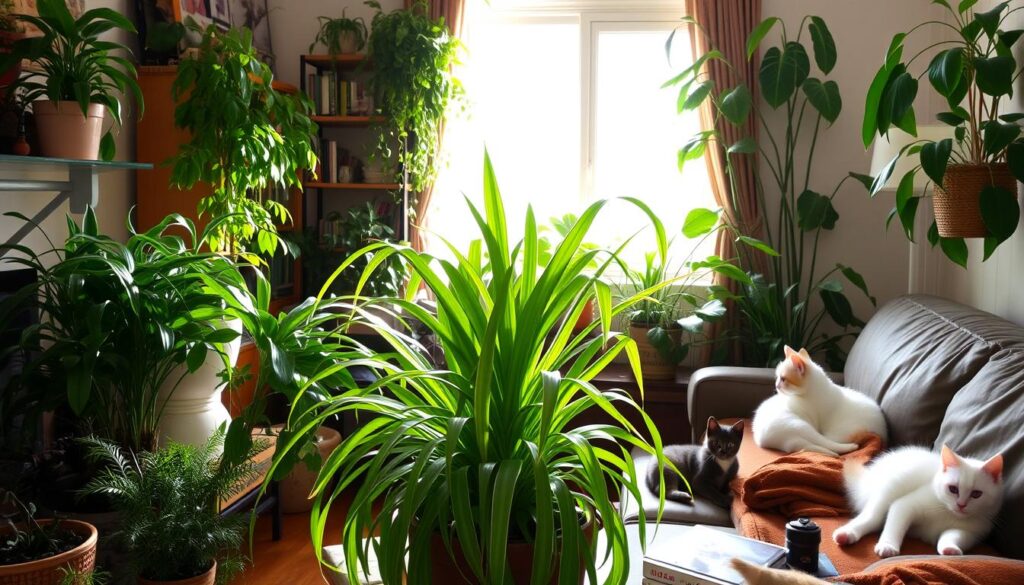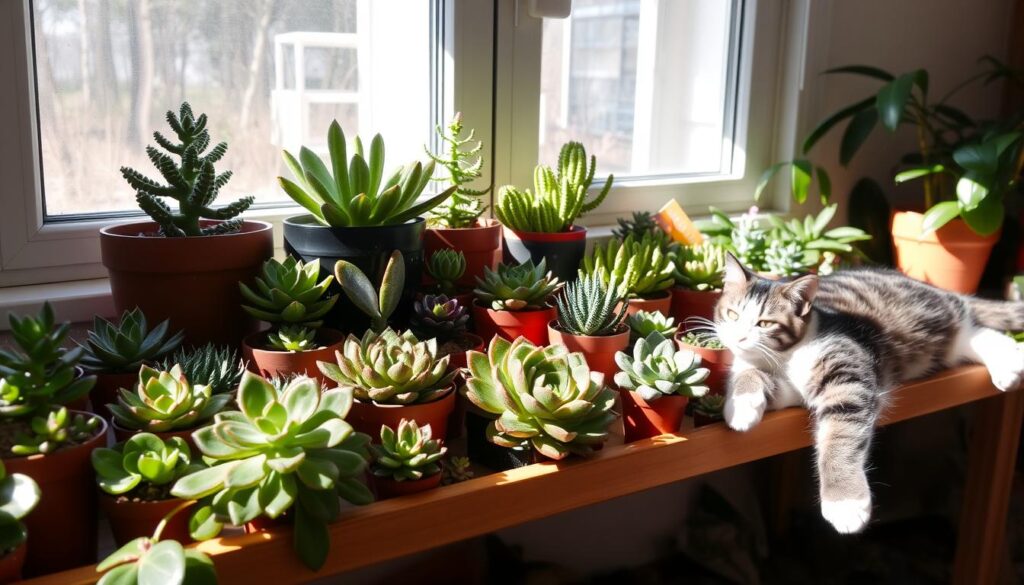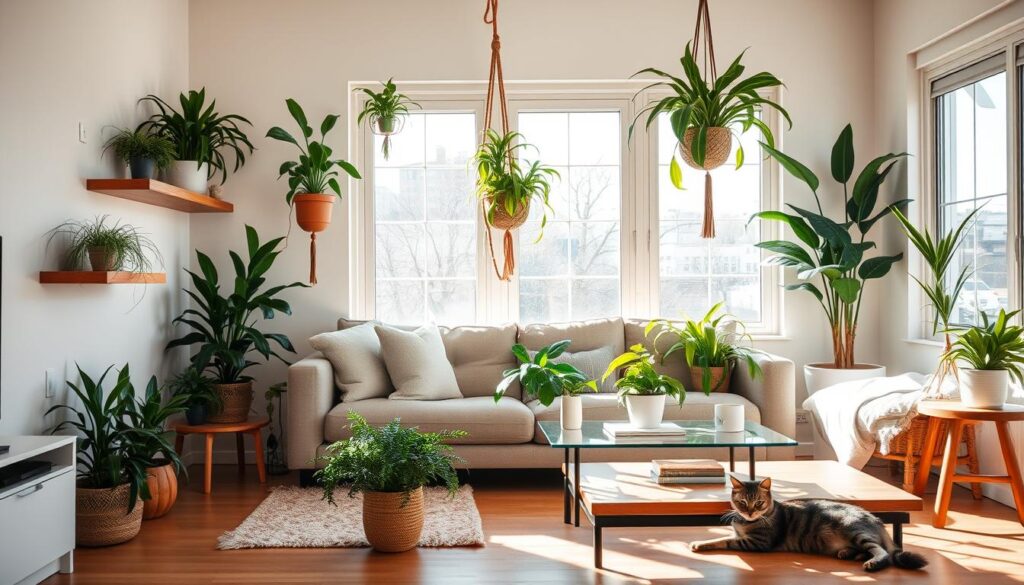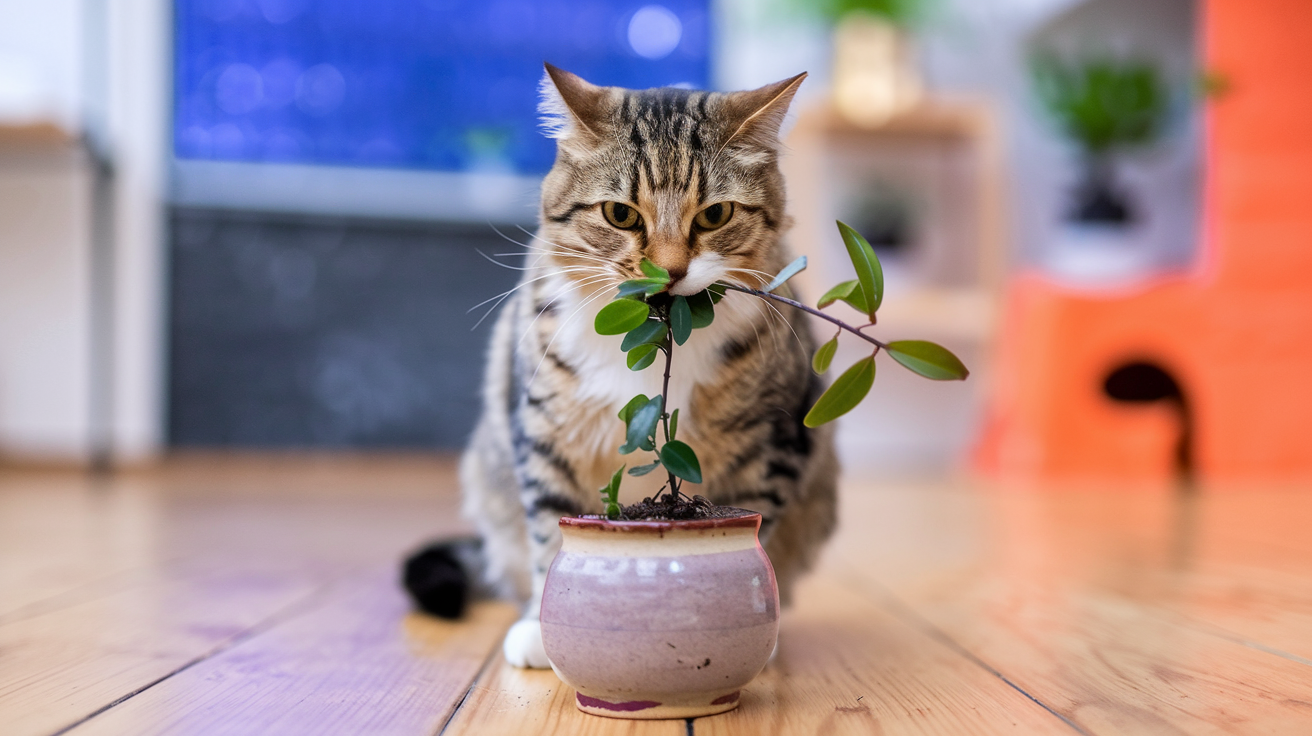As a cat owner, picking safe houseplants for homes with cats is key. Some plants can harm cats, so knowing the risks is important. Adding cat-safe plants to your home can clean the air and make it calmer.
Choosing safe plants lets you enjoy your home’s greenery without risking your cat’s health. Cat-safe plants are perfect for adding some green to your space without danger.
Key Takeaways
- Choose safe houseplants for homes with cats to ensure your cat’s safety and well-being.
- Certain plants can be toxic to cats, so it’s essential to be informed about the potential risks.
- Incorporating cat-safe houseplants into your home can have numerous benefits, including purifying the air and creating a calming environment.
- Safe houseplants for homes with cats can help create a harmonious and healthy home environment.
- Always research and choose cat-safe houseplants to avoid any potential risks to your cat’s health.
- By being mindful of your plant choices, you can enjoy the benefits of having plants in your home while keeping your cat safe.
Why Cat-Safe Houseplants Matter for Your Feline Friend
As a cat owner, it’s key to think about the plants in your home. Cats love to chew on plants, which can harm them. That’s why pet-friendly indoor plants are important. They help make a safe space for your cat to live and grow.
Cats eat plants for different reasons. They might like the feel or taste of certain plants. Or they might be looking for extra nutrients. Whatever the reason, it’s up to us to keep them safe.
Understanding Cats’ Plant-Eating Behavior
Cats are very careful about their grooming. But with plants, they can be careless. This can lead to them eating things that are bad for them. As a cat owner, knowing about toxic plants is crucial to keep your cat safe.
The Risks of Toxic Plants to Cats
Toxic plants can really hurt cats. If a cat eats a bad plant, it can get very sick. By picking pet-friendly indoor plants and feline-friendly plants, you can lower the risk of harm.
Benefits of Having Plants in Your Cat-Friendly Home
Having pet-friendly indoor plants and feline-friendly plants is good for your home too. They clean the air, make your space look better, and keep your cat happy. Adding these plants can make your home a better place for everyone.
Safe Houseplants for Homes with Cats: The Complete List
Choosing non-toxic plants for your home is important. As a cat owner, picking indoor plants safe for cats is key. This ensures your pet stays healthy. Here are some great options:
Some examples of safe houseplants include:
- Spider plants: easy to care for and great air purifiers
- Parlor palm: a elegant and low-maintenance option
- Peperomia: a small and adorable plant perfect for shelves or desks
These indoor plants safe for cats are not only beautiful. They also offer many benefits. They purify the air and help reduce stress. By picking non-toxic plants, you make a safe and healthy space for you and your cat.
Spider Plants: The Ultimate Cat-Safe Choice
Spider plants are a top pick for cat-friendly houseplants. They’re simple to care for and grow well in different light conditions. To keep your spider plant healthy, water it well and let the soil dry a bit before watering again. For more info on houseplants safe for pets, check out https://www.trupanion.com/pet-blog/article/indoor-plants-safe-for-cats.
Spider plants catch a cat’s eye with their long stems and leaves. Cats might play with the stems or chew on the leaves. To keep your spider plant safe, hang it in a basket or put it on a high shelf. This way, you can still admire it without worrying about your cat.

Growth Requirements and Care Tips
For your spider plant to thrive, give it bright, indirect light and keep the temperature between 60-75°F. Feed it a balanced fertilizer to help it grow strong. By following these tips, you and your cat can enjoy the plant together.
Why Cats Love Spider Plants
Cats find spider plants appealing because of their texture and movement. The plant’s stems and leaves can entertain your cat, who might enjoy watching them move. To keep your cat from chewing on the plant, offer them toys or scratching posts instead.
Beautiful Boston Ferns and Other Safe Trailing Plants
Many cat owners choose plants that are safe for cats in the home. They pick trailing plants for their beauty and ease of care. Boston ferns are a favorite, with their lush green fronds and ability to grow well in different lights.
These safe houseplants for homes with cats are not only pretty but also simple to maintain. This makes them perfect for pet owners who are always on the go.
To keep your Boston fern in top shape, water it often and ensure it has enough humidity. Fertilizing it now and then will help it grow strong. Other safe houseplants for homes with cats like the prayer plant and wandering jew are also great. They’re safe for cats and can enhance your home’s look.
Here are some tips for adding trailing plants to your cat-friendly home:
- Choose plants that are easy to care for and can thrive in a variety of lighting conditions.
- Consider using hanging baskets or planters to keep your plants out of reach of curious cats.
- Make sure to water and fertilize your plants regularly to keep them healthy and happy.
By following these tips and picking plants that are safe for cats in the home, you can make a beautiful space. This space will be safe and enjoyable for both you and your cat.
Moisture-Loving Options for Bathroom Gardens
Creating a bathroom garden that’s safe for cats means picking plants that love moisture. Plants like Calathea, Prayer Plants, and African Violets are great. They clean the air, control humidity, and make your bathroom look beautiful.
These plants are perfect for bathrooms because they handle high humidity and low light well. Adding them to your bathroom garden makes it peaceful and calming for you and your cat.
Calathea Varieties
Calathea plants have stunning leaves and do well in low light. They’re safe for cats, making your home healthy and pet-friendly.
Prayer Plants
Prayer Plants are beautiful and air-purifying. They’re safe for cats, creating a calm bathroom atmosphere for pet owners.
African Violets
African Violets are small and love moisture, fitting well in bathrooms. They’re safe for cats, keeping your home safe and healthy.
Desert Beauties: Safe Succulents for Your Home
For cat owners, finding safe, low-maintenance plants can be tough. Succulents are a great choice, being safe for cats and easy to care for. They are perfect for busy pet owners, needing little water and care.
Some safe succulent types for cats include Aloe vera, Echeveria, and Crassula. When picking succulents, watch out for sharp spines. Here are some tips to keep your cat and plants safe:
- Put succulents in hanging baskets or high shelves to keep them out of reach of curious cats.
- Use planters with wide bases to prevent them from tipping over.
- Choose succulent species with soft, rounded leaves to minimize the risk of injury.
By choosing non-toxic plants like succulents, you can make your home beautiful and safe for you and your cat. Succulents are stylish and easy to care for, making them perfect for cat owners who want greenery at home.

Herb Gardens That Both You and Your Cat Can Enjoy
Creating an indoor herb garden is a great way to add greenery to your home. It also makes a safe space for your cat. Many indoor plants safe for cats can be used in these gardens. Think about basil, mint, and lemongrass.
Some popular cat-safe culinary herbs include:
- Parsley
- Dill
- Chamomile
Catnip and cat grass are also good for indoor gardens. They’re safe for your cat to eat and keep them entertained. Adding these plants makes your garden beautiful and useful for both you and your cat.
Signs Your Cat Has Nibbled on a Plant
As a cat owner, knowing the signs of plant ingestion is key. This is especially true if you have houseplants safe for pets at home. Cats are curious and might nibble on plants, including safe houseplants for homes with cats. If you see any symptoms, act fast to protect your cat’s health.
Common signs include vomiting, diarrhea, feeling tired, and not wanting to eat. In serious cases, cats might have trouble breathing, shake, or even have seizures. If you think your cat ate a toxic plant, get vet help right away.
To avoid health problems, watch your cat around new plants. Keep plants out of reach, use covers, or pick safe houseplants for homes with cats. Knowing the signs and taking steps to protect your cat can keep them safe and healthy.
- Keep an eye on your cat’s behavior around plants
- Choose houseplants safe for pets that are non-toxic to cats
- Take immediate action if you suspect plant ingestion
It’s always safer to be cautious with your cat’s health and safety. Being informed and taking precautions can make your home a happy, healthy place for both you and your cat.
Strategic Plant Placement in Cat-Friendly Homes
Creating a harmonious home for you and your cat is important. Safe plants can purify the air and look great. Think about your home’s layout to keep your plants and cat safe.
Placing plants out of your cat’s reach is a good idea. Use shelves or hanging baskets to keep them safe. This is crucial for plants that are toxic to cats.
Height Considerations
Think about your cat’s climbing skills when choosing plant heights. Cats are very agile. So, place plants high up, like on shelves or from the ceiling.
Room-by-Room Placement Guide
Plan where to put plants in each room. In the living room, use high shelves or hanging baskets. In the bedroom, pick safe plants for your bedside table or dresser.

Creating Safe Plant Zones
Make plant-free zones in your home to keep your cat safe. This way, your cat can roam without danger. Safe zones make your home happy and healthy for both you and your cat.
How to Train Your Cat to Avoid Houseplants
To make a safe space for cat-safe houseplants and your cat, training is crucial. It takes patience and consistency to teach your cat to stay away from plants. Start by slowly introducing feline-friendly plants to your cat. Let them get used to their smell and taste.
Using positive rewards can help your cat not chew on plants. Give them treats and praise when they ignore the plants. You can also use citrus sprays or sticky tape to make plants less appealing. For more tips, check out expert advice on keeping cats away from plants.
Changing your cat’s environment can also help. Put plants out of reach or use barriers. Give your cat toys or scratching posts to keep them busy. This way, they’ll be less likely to chew on plants.
Some important strategies for training your cat include:
- Make sure they get enough exercise and mental play to avoid boredom and stress
- Give them different cat-safe houseplants to explore
- Watch how your cat interacts with plants to keep them safe
By using these tips and staying consistent, you can teach your cat to live with feline-friendly plants. This way, you can have a beautiful home with plants and a happy cat.
Common Toxic Plants to Keep Out of Your Home
As a cat owner, knowing which plants are harmful is key. Some houseplants, even though popular, can be toxic to cats. It’s important to know which ones to avoid to keep your home safe.
Popular but Dangerous Indoor Plants
Plants like lily, sago palm, and tulip are toxic to cats. They can cause anything from mild stomach issues to serious kidney problems. Always check if a plant is safe for cats before bringing it home.
Holiday Plants to Avoid
Be careful with plants during the holidays. Poinsettia, holly, and mistletoe are all harmful to cats. Choose non-toxic plants like cat-friendly flowers or branches instead.
Emergency Steps if Exposure Occurs
If your cat eats a toxic plant, act fast. Call your vet or a pet poison hotline right away. Always prioritize your cat’s health and choose indoor plants safe for cats.
Maintaining Healthy Plants While Protecting Your Cat
To keep your cat-friendly houseplants healthy, it’s key to protect your cat too. Use natural ways to stop cats from eating plants. For example, citrus peels or diluted vinegar can keep cats away.
It’s also important to pick safe fertilizers and soil. Organic fertilizers and pet-safe potting soil are good choices. You can even make your own fertilizer from kitchen waste or eggshells and coffee grounds.
Natural Deterrent Methods
- Citrus peels: Place lemon or orange peels around the plants to deter cats.
- Diluted vinegar spray: Spray a mixture of water and vinegar around the plants to keep cats away.
- Herbs: Certain herbs like mint and lemongrass can help deter cats from plants.
Safe Fertilizers and Soil Options
When picking fertilizers and soil for your plants, choose organic and non-toxic ones. This makes sure your plants and cat stay safe.
Seasonal Considerations for Indoor Plant Safety
As the seasons change, it’s key to think about how these changes affect plants that are safe for cats in the home. Changes in light, temperature, and humidity can change how plants grow and their toxicity.
To keep a safe and healthy space for you and your cat, adjust your care routines with the seasons. This means being careful with safe houseplants for homes with cats and protecting them from dangers.
- Watching how plants grow and changing how much water and food they get
- Ensuring each plant gets the right light and temperature
- Keeping plants safe from extreme weather, like strong winds or too much sun
By being careful and picking plants that are safe for cats in the home, you can have a lovely indoor garden. It will make you and your cat happy.
Essential Tools for Cat-Safe Plant Parenting
As a cat owner, it’s important to choose plants that are safe for your pets. Cat-safe houseplants can live well with your cats. But, you need the right tools to keep them safe. Get planters and stands that keep plants out of your cat’s reach.
For cat-safe plant care, you’ll need non-toxic pruning shears and watering cans. These tools let you care for your plants without harming your cat. Also, cat-safe plant sprays and cleaning products keep your plants healthy and pest-free. Use protective covers or barriers to stop your cat from getting to toxic plants.
To improve your cat-safe plant care, use plant identification apps and veterinary hotlines. These resources offer great advice on pet-friendly indoor plants. With the right tools and knowledge, you can have a beautiful indoor garden that you and your cat will love.
- Non-toxic pruning shears
- Watering cans
- Cat-safe plant sprays and cleaning products
- Protective covers or barriers
- Plant identification apps
- Veterinary hotlines
With these tools and a bit of creativity, you can create a beautiful and cat-safe indoor space. It will showcase your favorite pet-friendly indoor plants. This will make a happy and healthy home for you and your cat.
Creating Your Perfect Green Paradise for Both You and Your Feline
Creating a beautiful indoor garden that you and your cat can enjoy is possible. You can pick plants that are safe for cats and place them wisely. This way, you can make a lush, safe space for your cat to explore.
Picture a calm room with green plants everywhere. You could have Boston ferns hanging down or succulents standing tall. Choosing cat-safe plants lets you create a beautiful space that’s also safe for your pet.
Start making your dream green space today. It’s a place where nature’s beauty meets your pet’s safety. With what you’ve learned, you can create a space that’s good for both you and your cat.
FAQ
What are the most common houseplants that are safe for homes with cats?
Safe plants for cats include spider plants, Boston ferns, and Calathea varieties. Also, prayer plants, African violets, and many succulents are non-toxic. These plants can make your home safe for your cat.
Why is it important to choose cat-safe houseplants?
Cats often chew on plants, and many can be toxic. Choosing safe plants protects your cat from harm. It also makes your home safer for both you and your pet.
What are the benefits of having plants in a cat-friendly home?
Plants add beauty and improve air quality and humidity. They can also enrich your cat’s environment. With the right plants, your home can be healthier and more harmonious.
How can I safely incorporate spider plants into my cat-friendly home?
Spider plants are safe for cats and attractive to them. Hang them or place them high to keep your cat away. Trimming shoots can also help prevent chewing.
What are some moisture-loving, cat-safe plants that can thrive in a bathroom environment?
Calathea, prayer plants, and African violets love moisture and are safe for cats. They’re perfect for bathrooms. Just make sure to place them safely to avoid your cat getting to them.
How can I train my cat to avoid chewing on houseplants?
Use positive reinforcement and deterrents to stop plant chewing. Be consistent and patient. Introducing new plants slowly can help your cat get used to them.
What are some common toxic plants that should be kept out of a cat-friendly home?
Avoid plants like lilies, jade plants, pothos, and poinsettias. They’re toxic to cats. Always check a plant’s safety before bringing it home. If your cat eats a toxic plant, get vet help right away.
How can I maintain healthy, thriving houseplants while protecting my cat?
Use natural deterrents like citrus peels or vinegar to keep cats away. Choose safe fertilizers and soil. Clean your plants with non-toxic methods. This way, you can enjoy healthy plants and a happy cat.

